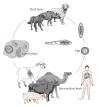Human echinococcosis: a neglected disease
- PMID: 20862339
- PMCID: PMC2939407
- DOI: 10.1155/2010/583297
Human echinococcosis: a neglected disease
Abstract
Echinococcosis is among the most neglected parasitic diseases. Development of new drugs and other treatment modalities receives very little attention, if any. In most developed countries, Cystic Echinococcosis (CE) is an imported disease of very low incidence and prevalence and is found almost exclusively in migrants from endemic regions. In endemic regions, predominantly settings with limited resources, patient numbers are high. Whole communities do not have access to appropriate treatment. The choice of treatment modalities is limited because of poor infrastructure and shortage of equipment and drugs. In this context, CE meets the criteria for a neglected disease. Furthermore, the terminology related to the designations around the parasite, its evolution and some therapeutic procedures is not uniform and sometimes inappropriate terms and wrong designations are used based on incorrect concepts. Although all of us know the different aspects of the disease it is pertinent to remember some important points and, above all, to clarify some aspects concerning the hydatid cyst's nomenclature in order to understand better the therapeutic options in the liver locations, particularly the different surgical approaches.
Figures









References
-
- Pawlowski Z, Eckert J, Vuitton D. Echinococcosis in humans: clinical aspects, diagnpsis and treatment. In: Eckert J, Gemmel MA, Meslin F-X, Pawlowski ZS, editors. WHO/OIE Manual on Echinococcosis in Humans and Animals: A Public Health Problem of Global Concern. Paris, France: World Health Organization and World Organization for Animal Health; 2001. pp. 20–66.
-
- Craig PS, McManus DP, Lightowlers MW, et al. Prevention and control of cystic echinococcosis. Lancet Infectious Diseases. 2007;7(6):385–394. - PubMed
-
- Ammann RW, Renner EC, Gottstein B, Grimm F, Eckert J, Renner EL. Immunosurveillance of alveolar echinococcosis by specific humoral and cellular immune tests: long-term analysis of the Swiss chemotherapy trial (1976–2001) Journal of Hepatology. 2004;41(4):551–559. - PubMed
-
- Schantz PM. The burden of echinococcosis. American Journal of Tropical Medicine and Hygiene. 2005;73(1):p. 1. - PubMed
LinkOut - more resources
Full Text Sources

